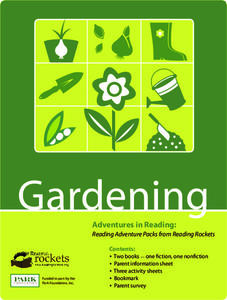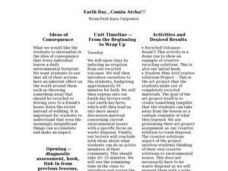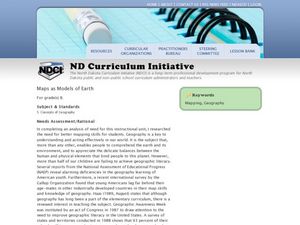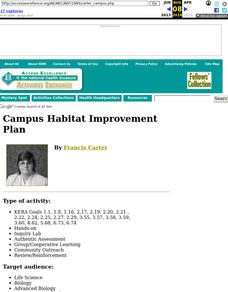PBS
Reading Adventure Pack: Rocks
A Reading Adventure Pack focuses on rocks. Scholars participate in three activities after reading a fiction and nonfiction text—The Jade Stone, a Chinese folktale adapted by Caryn Yacowitz, and Rocks in His Head by Carol Otis Hurst....
PBS
Reading Adventure Pack: Birds
A Reading Adventure Pack takes a close look at birds. After reading a fiction and nonfiction book, scholars craft a thaumatrope, begin a birding journal using their sense of sight and hearing, and build a model bird using supplies from...
PBS
Reading Adventure Pack: Gardening
A Reading Adventure Pack invites scholars to start gardening. Following a reading of two books—fiction and nonfiction—young green thumbs repurpose food containers to grow an herb garden in their kitchen, plant seeds in starter pots out...
Curated OER
Breaking News English: Noise Pollution in the Oceans
In this noise pollution in the oceans worksheet, students read the article, answer true and false questions, complete synonym matching, complete phrase matching, complete a gap fill, answer short answer questions, answer discussion...
Baylor College
How Do We Use Water?
Send youngsters home to survey how they use water in their homes. Then bring them together to discuss which uses are essential for our health and which are not. A helpful video offers teaching tips for this lesson plan, and a...
Environmental Protection Agency (EPA)
How Much Water Do You Use?
Incorporate reading strategies, math, research, and the scientific method into one lesson about water conservation. After reading a story about a landlady trying to determine how many people are living in an apartment, learners develop a...
SeaWorld
Marvelous Manatees
Here is an interesting lesson on the manatee for your upper graders or middle schoolers. A game is played where learners work together to complete a successful manatee migration. It's a board game, and all of the game components are...
Berkeley Lab
Virtual Frog Dissection Kit
Fluffy is one of the most common names for a pet frog. Fluffy, the digitized frog in this dissection kit, opens up quite literally to allow scholars to see what's inside. The basic kit encourages pupils to click on various organs to see...
Curated OER
Earth Day...Comin Atcha!!!
Pupils explore the idea of consequence that every individual leaves a daily environmental footprint. They read articles about creative solutions to solid waste issues and then create an artwork from household trash.
Curated OER
Earth's Poles
In this Earth's Poles worksheet, students survey, examine and dissect the North and South Magnetic Poles, the Earth's axis and summarize the Aurora legends. Students research six directives involving space weather and predicting answers.
Curated OER
Life Cycle Literature Briefs
Literature containing life cycle information is available from many sources. Several examples of this type of literature are listed below with a synopsis and sample questions for each. These examples have been taken from a variety of...
Curated OER
Maps as Models of Earth
Eighth graders use different types of maps to find locations and surface features. For this map-reading lesson students use a compass to find direction.
Curated OER
Finding an Earthquake's Epicenter
Students examine the process used to identify the epicenter of an earthquake. They identify the Richter scale and interpret a seismograph reading. They also view photographs of the aftermath of earthquakes.
Curated OER
Climate Change
Students define and associate words with the topic of climate change while completing associated worksheets. They read and discuss articles about climate change including the effects of global warming and the greenhouse effect.
Curated OER
Applied Science-Science and Math (2A) Post Lab
Second graders create a graph about TV watching. In this bar graph lesson plan, 2nd graders make a hypothesis about how much TV 2nd graders watch per week. They record their TV watching for a week and bring it to school to create a class...
Curated OER
Water Sources: Sprinkles (Newsletter)
In this science learning exercise, students investigate water sources and the environment. Students complete a rebus, a home water survey, a game about the journey of water, an activity on waste water, a water cleansing experiment and a...
Curated OER
What's Your Favorite Planet?
Fourth graders interpret a graph and make correlations using data. After taking a class survey, 4th graders create a class graph of their favorite planets. Working in small groups, they interpret the information and create at least ten...
Curated OER
Puffin Patrol
Bird diversity and the majestic puffin are the topics of today's lesson. Children discuss and look at images of puffins, and then they use felt to put a puffin body together. After that they talk about what and how puffins eat. They get...
Curated OER
Acid Mine Drainage
Students use cabbage, backing soda, cobblestones, and more to test the acid in the water. In this acid mine damage lesson plan, students complete 13 experiments to test and treat acid.
Curated OER
Campus Habitat Improvement Plan
Students work to improve a plot of land. They assess the needs of the environment and formulate a plan. They plant trees and gardens, build bird boxes, construct waterholes. etc.
Curated OER
Pond Theme Unit
For this pond theme worksheet students research facts on pond life. Students complete comprehension questions, crosswords, word search, and math puzzles. Students write a short report.
Curated OER
WaterWeb
In this water worksheet, students answer 10 multiple-choice questions about the water cycle. Students also describe how they think their community is involved in sustaining water resources and write a pretend radio announcement about...
Curated OER
Rocks, Rocks & More Rocks
Second graders work together to examine different types of rocks. They sort rocks according to their characteristics and properties.
Curated OER
Biomes and Regions of the United States
Young scholars examine and identify the characteristics of the biomes of the world. Using the Internet, they compare and contrast the similarities and differences and discover how living things are supported in the biomes. They discuss...

























